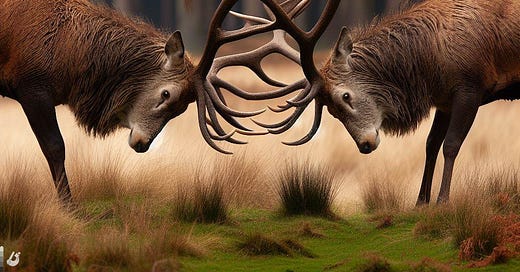Sexual Competition: In the Quest to Access Mates
Evolutionary history has made us the products of fierce competition: our ancestors. They fought rivals, courted desirable mates, and attracted females for reproduction, allowing us to exist today. This intricate mating game involves strategies like aggression, cooperation, gossip, deception, and ornamentation, all aiming to outshine rivals and secure partners.
This competition, termed sexual competition, revolves around the struggle for mating opportunities, driven by sexual strategies for reproductive success.
Sexual competition shapes us, fostering the evolution of traits and behaviours enhancing mating success, such as ornaments, weapons, displays, mate guarding, or infidelity.
Understanding sexual competition matters because it determines the evolution of different traits and behaviours, increasing reproductive success for males and emphasizing mate choice for females.
The dynamics of sexual competition depend on the operational sex ratio (OSR), defining which sex competes for access to mates. Limited female availability forces males into competition, and vice versa.
Male and female strategies in our species' mating game differ. Females set the rules, pressuring men to exert more effort in attracting them. This mate selection behaviour in men evolved to meet women's preferences. Ancestral females' preferences shaped successful reproduction, leading males to adapt to meet these criteria.
Geoffrey Miller writes in Mating Mind that Males compete for the quantity of females, and females compete for the quality of males. Our ancestors
male and female probably competed for mates differently. Males might compete with other mates by fighting, and forcing while females compete with other females by attracting mates.
Females compete with other females for high-quality mates, male parental investment, and particularly when resources are limited. On the other hand, male-male competition differs significantly.
Females may utilize strategies such as enhancing their physical attractiveness, spreading gossip, excluding rivals, or forming alliances to gain an advantage over their competitors.
According to evolutionary theory, males compete for mates because they have a higher potential reproductive rate than females, meaning that they can produce more offspring by mating with multiple females.
In ancestral times, with limited options available, competition among males for mates was intense. For example, if there were 15 males and 10 females, these males vied against each other to secure a partner. Despite their efforts, around 5 males would fail in this pursuit. Unable to access females from other groups, these individuals faced the possibility of their genes dying with them if they didn’t mate before passing away. This heightened the critical nature of this competition.
Today, although the quest for partners still involves competition, we benefit from a wide array of choices. If local options are limited, individuals can resort to social media or dating apps to expand their chances. The contemporary spectrum of choices available is vast compared to that of our ancestors.
However, our behaviour in seeking mates retains similarities to our ancestors' practices. Females, due to their higher investment in offspring, tend to be more selective and choosy in their mate selection.
In contrast, males often compete for access to fertile females or seek partners. From an evolutionary perspective, male-male competition for mates is driven by the higher potential reproductive rate of males, meaning that they can produce more offspring by mating with multiple females.
In early human societies resembling ancestral conditions, males competed by showcasing physical strength, hunting skills, bravery, generosity, and social status.
These traits signalled their ability to provide and protect, as well as their genetic quality and health. Forming coalitions with other males, they cooperated and competed with rival groups, enhancing their access to resources and females.
As agricultural societies emerged approximately 10,000 years ago, the landscape of male competition shifted toward accumulating wealth, land, and power. These resources enabled men to attract and support multiple partners while passing on inheritance to their offspring. Violent forms of competition, such as warfare and raiding, became prevalent, providing males with increased access to females while limiting their rivals' opportunities.
In more recent times within industrial and post-industrial societies, males have adjusted their approach by emphasizing intelligence, education, creativity, and personality. These qualities signify their ability to thrive in the modern world and their compatibility and attractiveness to females.
They engage in subtler and indirect forms of competition, signalling status, wealth, and morality, thereby elevating their prestige and reputation among both females and peers.
Despite the shifts that have occurred over time, the outward appearance may have changed, but the core behaviour remains fundamentally unchanged. Take, for instance, the transition from displaying physical strength and hunting skills to signalling status and wealth.
Although the method of presentation has evolved, the underlying behaviour of displaying oneself to attract mates has persevered throughout time.
The evolution of a wide range of weapons and aggressive behaviours among numerous male animals has been propelled by male-male competition. These encompass tools used to combat or intimidate rivals, such as horns, antlers, tusks, claws, spurs, or teeth.
These weapons and aggressive behaviours frequently originate from intrasexual selection, offering advantages to males in winning contests, asserting dominance, safeguarding territories, or thwarting rivals from mating with females.
We are less violent than other animals in the context of this sexual competition. But still human males use aggression, dominance, or status display to deter or defeat rivals and impress potential mates. these behaviours may signal their strength, fitness, and resourcefulness, which are attractive qualities for females.
We employ art, intelligence, humour, gossip, and status games in our pursuit of success in this competition. We utilize whatever strategies enable us to outperform other competitors.
The strategies that aided our ancestors in surviving the mating market, thereby achieving successful reproduction, have left us with elements of their traits, characteristics, and behaviours.
As we navigate the complexities of modern courtship and competition, we carry within us a legacy shaped by millennia of evolutionary heritage—a testament to the enduring influence of our ancestors' endeavours in the ongoing quest for successful reproduction and the perpetuation of our genetic legacy.




